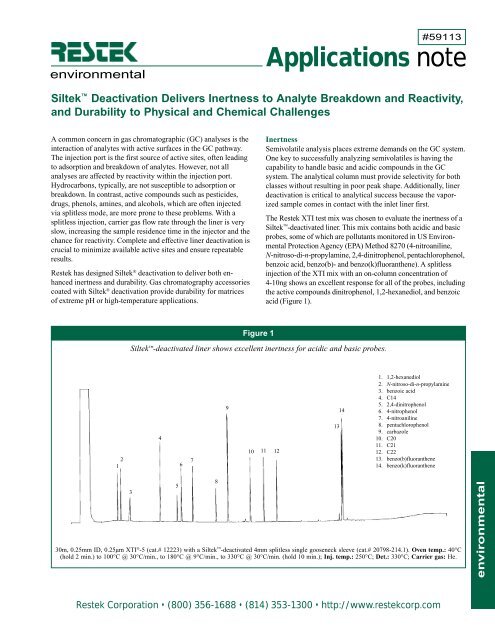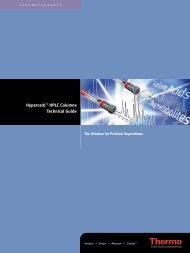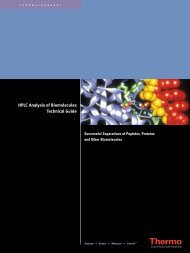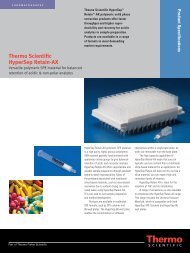Siltek™ Deactivation Delivers Inertness to Analyte ... - Interscience
Siltek™ Deactivation Delivers Inertness to Analyte ... - Interscience
Siltek™ Deactivation Delivers Inertness to Analyte ... - Interscience
You also want an ePaper? Increase the reach of your titles
YUMPU automatically turns print PDFs into web optimized ePapers that Google loves.
environmental<br />
Applications note<br />
Restek Corporation • (800) 356-1688 • (814) 353-1300 • http://www.restekcorp.com<br />
#59113<br />
Siltek <strong>Deactivation</strong> <strong>Delivers</strong> <strong>Inertness</strong> <strong>to</strong> <strong>Analyte</strong> Breakdown and Reactivity,<br />
and Durability <strong>to</strong> Physical and Chemical Challenges<br />
A common concern in gas chroma<strong>to</strong>graphic (GC) analyses is the<br />
interaction of analytes with active surfaces in the GC pathway.<br />
The injection port is the first source of active sites, often leading<br />
<strong>to</strong> adsorption and breakdown of analytes. However, not all<br />
analyses are affected by reactivity within the injection port.<br />
Hydrocarbons, typically, are not susceptible <strong>to</strong> adsorption or<br />
breakdown. In contrast, active compounds such as pesticides,<br />
drugs, phenols, amines, and alcohols, which are often injected<br />
via splitless mode, are more prone <strong>to</strong> these problems. With a<br />
splitless injection, carrier gas flow rate through the liner is very<br />
slow, increasing the sample residence time in the injec<strong>to</strong>r and the<br />
chance for reactivity. Complete and effective liner deactivation is<br />
crucial <strong>to</strong> minimize available active sites and ensure repeatable<br />
results.<br />
Restek has designed Siltek ® deactivation <strong>to</strong> deliver both enhanced<br />
inertness and durability. Gas chroma<strong>to</strong>graphy accessories<br />
coated with Siltek ® deactivation provide durability for matrices<br />
of extreme pH or high-temperature applications.<br />
2<br />
1<br />
3<br />
4<br />
5<br />
Figure 1<br />
Siltek -deactivated liner shows excellent inertness for acidic and basic probes.<br />
6<br />
7<br />
8<br />
9<br />
<strong>Inertness</strong><br />
Semivolatile analysis places extreme demands on the GC system.<br />
One key <strong>to</strong> successfully analyzing semivolatiles is having the<br />
capability <strong>to</strong> handle basic and acidic compounds in the GC<br />
system. The analytical column must provide selectivity for both<br />
classes without resulting in poor peak shape. Additionally, liner<br />
deactivation is critical <strong>to</strong> analytical success because the vaporized<br />
sample comes in contact with the inlet liner first.<br />
The Restek XTI test mix was chosen <strong>to</strong> evaluate the inertness of a<br />
Siltek-deactivated liner. This mix contains both acidic and basic<br />
probes, some of which are pollutants moni<strong>to</strong>red in US Environmental<br />
Protection Agency (EPA) Method 8270 (4-nitroaniline,<br />
N-nitroso-di-n-propylamine, 2,4-dinitrophenol, pentachlorophenol,<br />
benzoic acid, benzo(b)- and benzo(k)fluoranthene). A splitless<br />
injection of the XTI mix with an on-column concentration of<br />
4-10ng shows an excellent response for all of the probes, including<br />
the active compounds dinitrophenol, 1,2-hexanediol, and benzoic<br />
acid (Figure 1).<br />
10 11 12<br />
1. 1,2-hexanediol<br />
2. N-nitroso-di-n-propylamine<br />
3. benzoic acid<br />
4. C14<br />
5. 2,4-dinitrophenol<br />
6. 4-nitrophenol<br />
7. 4-nitroaniline<br />
8. pentachlorophenol<br />
9. carbazole<br />
10. C20<br />
11. C21<br />
12. C22<br />
13. benzo(b)fluoranthene<br />
14. benzo(k)fluoranthene<br />
30m, 0.25mm ID, 0.25µm XTI ® -5 (cat.# 12223) with a Siltek -deactivated 4mm splitless single gooseneck sleeve (cat.# 20798-214.1). Oven temp.: 40°C<br />
(hold 2 min.) <strong>to</strong> 100°C @ 30°C/min., <strong>to</strong> 180°C @ 9°C/min., <strong>to</strong> 330°C @ 30°C/min. (hold 10 min.); Inj. temp.: 250°C; Det.: 330°C; Carrier gas: He.<br />
13<br />
14<br />
environmental
Thermal Stability<br />
To test the durability of the Siltek ® liner deactivation, two<br />
sources of stress were investigated—high inlet temperature over<br />
a period of 10 days and repeated exposure <strong>to</strong> aqueous injections<br />
of low, then high pH. High inlet temperatures can promote<br />
degradation of the deactivation layer by causing it <strong>to</strong> bake or<br />
bleed off of the liner. In the first study, a baseline splitless XTI<br />
injection was performed, and response fac<strong>to</strong>rs (relative <strong>to</strong> C14)<br />
were calculated. The injection port was then set at 330°C<br />
overnight and another XTI injection was made. This process was<br />
continued for 10 days. After 10 days at 330°C, the Siltek ®<br />
deactivation retained its integrity, achieving essentially unchanged<br />
response fac<strong>to</strong>rs, even for the critical probes (Figure 2).<br />
Resistance <strong>to</strong> Chemical Attack<br />
For the next durability study, a Siltek ® -deactivated liner was<br />
repeatedly exposed <strong>to</strong> aqueous HCl injections, pH 1.4. The<br />
ability <strong>to</strong> withstand low pH aqueous samples is important with<br />
environmental applications that require acidification of the<br />
matrix. Very low or very high pH samples can cause pinpoint<br />
holes in the deactivation layer that will eventually undercut the<br />
layer and strip it away. For this study, a baseline XTI injection<br />
was made via direct injection and relative response fac<strong>to</strong>rs were<br />
calculated. In the direct injection mode, a leak-free connection is<br />
formed in the liner, minimizing sample exposure within the<br />
injection port. Ten microliters of the pH 1.4 sample were<br />
injected, followed by a direct injection of the XTI test mixture.<br />
Response Relative <strong>to</strong> C14<br />
Figure 2<br />
This cycle continued until a <strong>to</strong>tal of 180µL were injected (Figure<br />
3). Key probes, such as 2,4-dinitrophenol (DNP), pentachlorophenol<br />
(PCP), N-nitroso-di-n-propylamine (n-propylamine),<br />
and 1,2-hexanediol (diol) retained their responses up <strong>to</strong> at least<br />
120µL injected.<br />
The experiment was repeated with an identical set-up using<br />
aqueous NH OH injections, pH 10.1 (Figure 4). Under these<br />
4<br />
demanding conditions, the response for the XTI compounds was<br />
consistent for 70 injections. As expected, the response of the<br />
acidic compounds began <strong>to</strong> decrease with repeated injections but<br />
many compounds continued <strong>to</strong> have excellent response for more<br />
than 120µL injections.<br />
Siltek ® deactivation offers both inertness and resistance <strong>to</strong><br />
temperature and pH extremes within a GC system. It is available<br />
as a deactivation for fused silica guard columns and inlet liners.<br />
For more information on Siltek —<br />
the next generation of deactivation,<br />
please request our Siltek Benefits<br />
brochure (cat.# 59803).<br />
Siltek deactivation remains effective at an injection port temperature of 330°C for ten days.<br />
1.1<br />
1.0<br />
0.9<br />
0.8<br />
0.7<br />
0.6<br />
0.5<br />
0.4<br />
0.3<br />
0.2<br />
0.1<br />
Day 1 Day 5 Day 7 Day 9<br />
# Days Injection Port at 330°C<br />
benzoic acid<br />
4-nitrophenol<br />
pentachlorophenol<br />
2,4-dinitrophenol<br />
1,2-hexanediol<br />
N-nitroso-di-n-propylamine<br />
4-nitroaniline<br />
30m, 0.25mm ID, 0.25µm XTI ® -5 (cat.# 12223) with a Siltek -deactivated splitless sleeve (cat.# 20798-214.1). Oven temp.: 40°C (hold 2 min.) <strong>to</strong><br />
190°C @ 6°C/min., <strong>to</strong> 330°C @ 30°C/min. (hold 10 min.); Inj. temp.: 330°C; Det.: 330°C; Carrier gas: He.<br />
Restek Corporation • (800) 356-1688 • http://www.restekcorp.com
Figure 3<br />
Difficult probes* retain their response on Siltek deactivation up <strong>to</strong> 120µL of an aqueous solution of pH 1.4.<br />
Response Relative <strong>to</strong> C14<br />
1.0<br />
0.9<br />
0.8<br />
0.7<br />
0.6<br />
0.5<br />
0.4<br />
0.3<br />
0.2<br />
0.1<br />
120µL<br />
10 30 50 70 100 120 140 160 180<br />
µL Aqueous HCl (pH=1.4)<br />
30m, 0.25mm ID, 0.25µm XTI ® -5 (cat.# 12223) with a Siltek -deactivated 4mm open-<strong>to</strong>p Uniliner ® w/o wool (cat.# 20843-214.1).<br />
Oven temp.: 40°C (hold 2 min.) <strong>to</strong> 190°C @ 6°C/min., <strong>to</strong> 330°C @ 30°C/min. (hold 10 min.); Inj. temp.: 250°C; Det.: 330°C; Carrier gas: He.<br />
Figure 4<br />
benzoic acid<br />
4-nitrophenol<br />
pentachlorophenol*<br />
4-nitroaniline<br />
N-nitroso-di-n-propylamine*<br />
2,4-dinitrophenol*<br />
1,2-hexanediol*<br />
Response for XTI compounds on Siltek deactivation was consistent for 70 injections of an aqueous solution at pH 10.1.<br />
Response Relative <strong>to</strong> C14<br />
1.0<br />
0.9<br />
0.8<br />
0.7<br />
0.6<br />
0.5<br />
0.4<br />
0.3<br />
0.2<br />
0.1<br />
70 injections<br />
0 20 40 60 80 100<br />
µL Aqueous NH4OH (pH 10.1)<br />
4-nitroaniline<br />
4-nitrophenol<br />
benzoic acid<br />
pentachlorophenol<br />
N-nitroso-di-n-propylamine<br />
1,2-hexanediol<br />
2,4-dinitrophenol<br />
30m, 0.25mm ID, 0.25µm XTI ® -5 (cat.# 12223) with a Siltek -deactivated 4mm open-<strong>to</strong>p Uniliner ® w/o wool (cat.# 20843.214.1).<br />
Oven temp.: 40°C (hold 2 min.) <strong>to</strong> 190°C @ 6°C/min., <strong>to</strong> 330°C @ 30°C/min. (hold 10 min.); Inj. temp.: 250°C; Det.: 330°C; Carrier gas: He.<br />
Restek Corporation • (800) 356-1688 • http://www.restekcorp.com
XTI ® -5 Columns<br />
ID df (µm) Temp. limits 15m 30m<br />
0.25mm 0.25 -60 <strong>to</strong> 360°C 12220 12223<br />
0.50 -60 <strong>to</strong> 330/350°C 12235 12238<br />
1.00 -60 <strong>to</strong> 325/350°C 12250 12253<br />
0.32mm 0.25 -60 <strong>to</strong> 360°C 12221 12224<br />
0.50 -60 <strong>to</strong> 330/350°C 12236 12239<br />
1.00 -60 <strong>to</strong> 325/350°C 12251 12254<br />
0.53mm 0.50 -60 <strong>to</strong> 330/360°C 12237 12240<br />
1.00 -60 <strong>to</strong> 325/350°C 12252 12255<br />
1.50 -60 <strong>to</strong> 310/330°C 12267 12270<br />
Liner ID/OD/Length<br />
type (mm) ea. 5-pk. 25-pk.<br />
4mm split w/wool 4.0/6.3/78.5 20781 20782 20783<br />
2mm splitless 2.0/6.5/78.5 20712 20713 20714<br />
4mm splitless 4.0/6.5/78.5 20772 20773 20774<br />
4mm gooseneck 4.0/6.5/78.5 20798 20799 20800<br />
4mm double gooseneck 4.0/6.5/78.5 20784 20785 20786<br />
Cyclosplitter ® Inlet Liners for HP GCs<br />
4.0/6.3/78.5 20706 20707 20708<br />
Liner<br />
Inlet Liners for Varian GCs<br />
ID/OD/Length<br />
type (mm) ea. 5-pk. 25-pk.<br />
2mm splitless 2.0/6.3/74 20721 20722 20723<br />
4mm splitless 4.0/6.3/74 20904 20905 20906<br />
0.5mm SPI 0.53/4.6/54 20775 20776 20777<br />
0.8mm SPI 0.80/4.6/54 20778 20779 20780<br />
SPI with buffer 2.4/4.6/54 20850 20851 20852<br />
Restek Trademarks: Cyclosplitter, Press-Tight, Rtx, Siltek, Uniliner.<br />
For permission <strong>to</strong> reproduce any portion of this application note, please contact Restek’s publications/graphics department by phone (ext. 2128) or FAX.<br />
© Copyright 2000, Restek Corporation<br />
Product Listing<br />
Siltek -Deactivated Guard Columns<br />
Nominal ID Nominal OD 5m 10m<br />
0.25mm 0.37 + 0.04mm 10026 10036<br />
0.32mm 0.45 + 0.04mm 10027 10037<br />
0.53mm 0.69 + 0.04mm 10028 10038<br />
Siltek -Deactivated Press-Tight ® Connec<strong>to</strong>rs<br />
Type Qty. cat.#<br />
straight 25-pk. 20449<br />
angled ‘Y’ 3-pk. 20469<br />
For other Siltek -deactivated Press-Tight ® connec<strong>to</strong>rs, add suffix “-266”<br />
<strong>to</strong> the catalog number.<br />
Siltek -Deactivated Inlet Liners<br />
Siltek with Siltek with<br />
Siltek Siltek -deact. wool CarboFrit Qty.<br />
-214.1 -213.1 -216.1 each<br />
-214.5 -213.5 -216.5 5-pk.<br />
-214.25 -213.25 -216.25 25-pk.<br />
For Siltek -deactivated liners, add the corresponding suffix number <strong>to</strong> the<br />
liner’s catalog number.<br />
Siltek -Deactivated Glass Wool<br />
Qty. cat.#<br />
10 grams 21100<br />
For more information on Siltek —<br />
the next generation of deactivation,<br />
please request our Siltek Benefits<br />
brochure (cat.# 59803).<br />
USA: 110 Benner Circle, Bellefonte, PA 16823 • phone: (800) 356-1688 • fax: (814) 353-1309<br />
Germany: Schaberweg 23, 61348 Bad Homburg • phone: 06172 2797 0 • fax: 06172 2797 77<br />
France: 1, rue Montespan, 91024 Evry Cedex • phone: 33 01 60 78 32 10 • fax: 33 01 60 78 70 90<br />
Thames Restek UK Ltd.: Fairacres Industrial Centre, Dedworth Road, Windsor, Berkshire • SL4 4LE<br />
phone: 01753 624111 • fax: 01753 624666<br />
Restek Corporation • (800) 356-1688 • (814) 353-1300 • http://www.restekcorp.com





